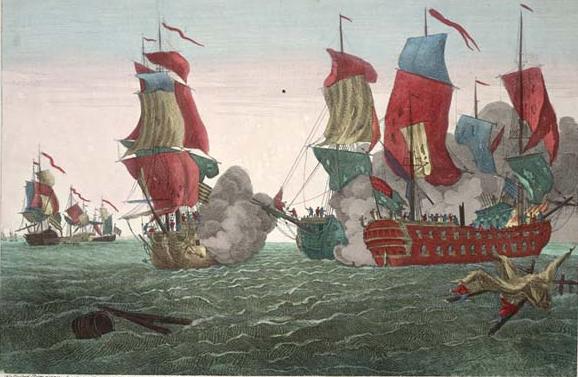While the fire was raging in so terrifying a manner, the water was entering the ship in many places. The rudder had been cut entirely through, the transoms were driven in, and the rotten timbers of the old ship, from the main-mast aft, were shattered and almost entirely separated, as if the ship had been sawn through by ice. . . .”
Continuing “I Have Not Yet Begun to Fight!”,
our selection from The Life of John Paul Jones by Alexander Slidell Mackenzie published in 1841. The selection is presented in seven easy 5 minute installments. For works benefiting from the latest research see the “More information” section at the bottom of these pages.
Previously in “I Have Not Yet Begun to Fight!”
Time: September 23, 1779
Place: North Sea off Flambough Head, Yorkshire, Great Britain

Public Domain Image From Wikipedia.
As another evidence of the strange mêlée which attended this engagement, and of the discouraging circumstances under which the Richard fought, it may be mentioned that eight or ten of her crew, who were, of course, Englishmen, got into a boat, which was towing astern of the Serapis, and escaped to Scarborough during the height of the engagement. This defection, together with the absence of the second lieutenant with fifteen of the best men, the loss of twenty-four men on the coast of Ireland, added to the number who had been sent away in prizes, reduced Jones’ crew to a very small number, and greatly diminished his chance of success, which was due at length solely to his own indomitable courage.
Meantime the fire, which was still kept up from the lower-deck guns of the Serapis, where the seamen were ignorant of the scene of surrender which had taken place above, was arrested by an order from Lieutenant Dale. The action had continued without cessation for three hours and a half. When it at length ceased, Jones got his ship clear of the Serapis and made sail. As the two separated, after being so long locked in deadly struggle, the main-mast of the Serapis, which had been for some time tottering, and which had only been sustained by the interlocking of her yards with those of the Richard, went over the side with a tremendous crash, carrying the mizzen-topmast with it. Soon after, the Serapis cut her cable and followed the Richard.
The exertions of captors and captives were now necessary to extinguish the flames which were raging furiously in both vessels. Its violence was greatest in the Richard, where it had been communicated below from the lower-deck guns of the Serapis. Every effort to subdue the flames seemed for a time to be unavailing. In one place they were raging very near the magazine, and Jones at length had all the powder taken out and brought on deck, in readiness to be thrown overboard. In this work the officers of the Serapis voluntarily assisted.
While the fire was raging in so terrifying a manner, the water was entering the ship in many places. The rudder had been cut entirely through, the transoms were driven in, and the rotten timbers of the old ship, from the main-mast aft, were shattered and almost entirely separated, as if the ship had been sawn through by ice; so much so that Jones says that toward the close of the action the shot of the Serapis passed completely through the Richard; and the stern-post and a few timbers alone prevented the stern from falling down on the gunroom deck. The water rushed in through all these apertures, so that at the close of the action there were already five feet of water in the hold. The spectacle which the old ship presented the following morning was dreadful beyond description. Jones says in his official report: “A person must have been eye-witness to form a just idea of the tremendous scene of carnage, wreck, and ruin that everywhere appeared. Humanity cannot but recoil from the prospect of such finished horror, and lament that war should produce such fatal consequences.”
Captain Pearson also notices, in his official letter to the Admiralty, the dreadful spectacle the Richard presented. He says: “On my going on board the Bonhomme Richard I found her to be in the greatest distress; her counters and quarters on the lower deck entirely drove in, and the whole of her lower-deck guns dismounted; she was also on fire in two places, and six or seven feet of water in her hold, which kept increasing all night and the next day till they were obliged to quit her, and she sunk with a great number of her wounded people on board her.” The regret which he must, at any rate, have felt in surrendering, must have been much augmented by these observations, and by what he must have seen of the motley composition of the Richard’s crew.
On the morning after the action a survey was held upon the “Poor Richard,” which was now, more than ever, entitled to her name. After a deliberate examination, the carpenters and other surveying officers were unanimously of opinion that the ship could not be kept afloat so as to reach port, if the wind should increase. The task of removing the wounded was now commenced, and completed in the course of the night and following morning. The prisoners who had been taken in merchant-ships were left until the wounded were all removed. Taking advantage of the confusion, and of their superiority in numbers, they took possession of the ship, and got her head in for the land, toward which the wind was now blowing. A contest ensued, and, as the Englishmen had few arms, they were speedily overcome. Two of them were shot dead, several wounded and driven overboard, and thirteen of them got possession of a boat and escaped to the shore.
| <—Previous | Master List | Next—> |
More information here.
Leave a Reply
You must be logged in to post a comment.